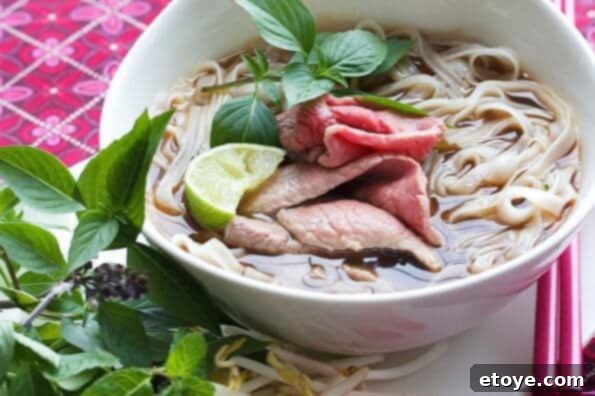Authentic Vietnamese Pho Recipe: Crafting the Perfect Beef Noodle Soup at Home
Embark on a culinary journey to Vietnam right from your kitchen with this authentic Pho recipe, masterfully adapted from the acclaimed cookbook author and leading Vietnamese cuisine expert, Andrea Nguyen. This isn’t just any beef noodle soup; it’s a meticulously crafted experience featuring a broth that is remarkably light yet bursting with profound, savory flavors. Infused with a harmonious blend of aromatic spices like cinnamon, star anise, and cardamom, each spoonful promises an utterly addictive and deeply satisfying meal that will transport your senses straight to the bustling streets of Hanoi or Ho Chi Minh City. Prepare to discover the secrets behind a truly exceptional homemade Pho, a dish revered worldwide for its comforting warmth and complex taste profile.
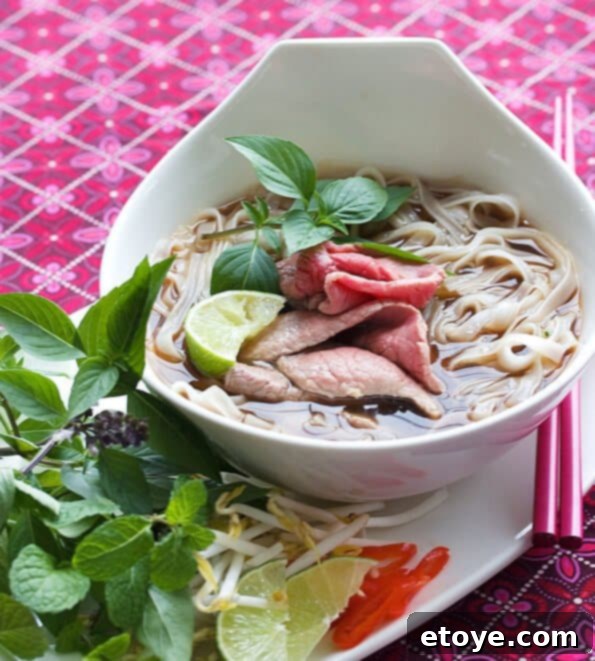
The Essence of Vietnamese Pho: What Makes This Recipe Stand Out
Creating an extraordinary bowl of Pho involves more than just simmering ingredients; it’s an art form perfected through precise techniques and careful selection. This particular recipe distinguishes itself by focusing on the core elements that define a truly authentic and deeply satisfying Vietnamese beef noodle soup. Here’s why this rendition of Pho is simply unparalleled:
Masterful Broth: The Heart of Authentic Pho
- Superior Beef Bones for Unrivaled Depth: The foundation of any great Pho is its broth, and this recipe insists on using the very best kind of beef bones—specifically knuckle and leg bones. These bones are rich in gelatin and marrow, which render a broth with incredible body, a silky mouthfeel, and a depth of flavor that can’t be achieved with leaner cuts. This emphasis on bone quality is paramount to creating that signature savory backbone of Pho.
- A Pristine, Crystal-Clear Broth: Achieving a clean, clear beef broth is a hallmark of expertly made Pho. This recipe employs critical steps, such as thorough parboiling and diligent skimming, to eliminate impurities and scum. The result is a visually appealing broth that is pure in taste, allowing the nuanced spice and beef flavors to shine without any cloudiness or off-notes.
- A Deeply Savory and Layered Flavor Profile: Beyond mere clarity, this Pho soup boasts a profoundly savory and complex flavor. The slow simmering process allows the beef bones, charred aromatics (onion and ginger), and whole spices to fully release their essences, building layer upon layer of umami-rich taste. Each ingredient contributes to a symphony of flavors—sweet, savory, aromatic, and subtly spicy—creating a broth that is both comforting and exhilarating.
Quality Ingredients, Unforgettable Taste
While the broth is undeniably the soul of Pho, the accompanying ingredients play crucial supporting roles. From the perfectly cooked noodles to the thinly sliced meats and vibrant garnishes, every component is carefully selected to contribute to the overall texture, aroma, and flavor harmony of the dish.
Essential Ingredients for Your Homemade Pho Experience
Crafting authentic Vietnamese Pho requires a thoughtful selection of ingredients, each playing a vital role in building the soup’s distinctive aroma and flavor profile. Below, we break down the components needed for both the rich, complex broth and the vibrant, fresh Pho bowls.
For the Aromatic Pho Broth
The broth is the very foundation of Pho, and its flavor depends heavily on the quality and freshness of these core ingredients:
- Yellow Onions: Unpeeled and halved, these are charred to release their natural sweetness and a subtle smoky depth that perfectly complements the savory beef.
- Fresh Ginger: Also unpeeled and halved, charring the ginger awakens its pungent, spicy notes, adding a warming aromatic layer to the broth.
- Beef Leg or Knuckle Bones: These are non-negotiable for a rich, gelatinous, and flavorful broth. Look for meaty bones with marrow for maximum richness.
- Water: The base for your broth, ensuring a clean, pure liquid for simmering.
- Whole Spices: A precise blend of whole spices defines Pho’s iconic aroma. This includes:
- Star Anise: For a distinctive licorice-like sweetness.
- Whole Cloves: Contributing a warm, intense aroma.
- Cinnamon Stick: Lending a sweet, woody fragrance.
- Coriander Seeds (optional): For a bright, citrusy note.
- Cardamom (optional): Adding a slightly floral and earthy complexity.
- Fennel Seeds (optional): For a hint of licorice and sweetness, complementing the star anise.
- Beef Chuck (or Rump Brisket/Cross Rib Roast): A boneless cut of beef that simmers in the broth, becoming tender and infused with flavor, later sliced for serving.
- Fish Sauce: This essential Vietnamese condiment adds a fundamental layer of savory umami and a hint of saltiness, balancing the broth’s flavors.
- Sugar: A touch of sweetness (or a traditional chunk of yellow rock sugar) helps to round out the flavor profile and enhance the broth’s richness.
Building Your Perfect Pho Bowl
Once your exquisite broth is ready, these fresh ingredients come together to form the delightful individual servings:
- Flat Rice Noodles: The quintessential noodle for Pho, providing a soft, slippery texture. Available both dried and fresh.
- Cooked Beef (from the broth): The tender beef chuck, rump brisket, or roast that has simmered in your broth, now thinly sliced.
- Raw Beef (Round Sirloin, London Broil, Flank Steak, or Tri-Tip Steak): Very thinly sliced, this raw beef is cooked to perfection by the hot broth just before serving, ensuring ultimate tenderness.
- Yellow Onion: Sliced paper-thin and often soaked in cold water to reduce pungency, adding a delicate crunch and mild onion flavor.
- Scallions: The green parts, thinly sliced, for a fresh, mild oniony bite and vibrant color.
- Cilantro: Fresh leafy tops, chopped, offering a bright, herbaceous aroma and flavor that lifts the entire dish.
Fresh Garnishes: The Essential Finishing Touch for Pho
Garnishes are not merely decorative; they are integral to the Pho experience, allowing each diner to customize their bowl with refreshing textures and bold flavors. Arrange these on a communal plate for everyone to enjoy:
- Bean Sprouts: For a delightful, crisp crunch and fresh, earthy taste.
- Mint: Adding a cool, refreshing herbal note.
- Basil (Thai Basil): With its distinct anise-like flavor, it’s a classic pairing for Pho.
- Chiles (Thai or Serrano): Thinly sliced, these provide a customizable kick of heat.
- Lime Wedges: A squeeze of fresh lime juice brightens the broth and cuts through its richness, adding a tangy zest.
Step-by-Step Guide to Crafting Authentic Vietnamese Pho
Making Pho at home is a rewarding experience that, while requiring a bit of time, is surprisingly straightforward with the right techniques. Follow these steps to create a truly unforgettable bowl of Vietnamese beef noodle soup.
Preparing the Deeply Flavorful Broth
Charring Aromatics for Depth: Begin by setting your oven rack approximately 8 inches below the heating element and preheating your oven to a low broil. Place the halved yellow onions and ginger, cut-side up, on a baking sheet. Lightly brush the cut surfaces with a small amount of oil. Broil until the onions and ginger become slightly charred and fragrant, typically about 10 minutes, remembering to turn them halfway through for even charring. This crucial step caramelizes their natural sugars, imparting a wonderful sweetness and smoky depth to your broth. Once charred, remove from the oven and allow them to cool.
The Essential Parboiling of Beef Bones: Fill a large stockpot (approximately 12-quart capacity) with water and bring it to a rapid, rolling boil. Carefully lower the beef bones into the vigorously boiling water. Allow the water to return to a full, rolling boil and continue to boil the bones for a precise 3 minutes. This intense boiling process is vital for releasing impurities, such as blood particles and excess fat, which would otherwise cloud your broth and introduce undesirable flavors. After 3 minutes, carefully dump the bones and the water into a clean sink. Rinse the bones thoroughly under cool running water to wash off any clinging residue. Quickly scrub your stockpot clean. Refill the pot with approximately 6 quarts of fresh, clean water. Return the rinsed bones to the clean pot. Add the charred onion and ginger, your selected whole spices, the boneless beef chuck, fish sauce, and sugar to the pot.
Simmering for Perfection: Bring the water in the pot to a boil over high heat, then immediately reduce the heat to a gentle simmer. It is crucial to maintain a very low, gentle simmer; rapid boiling will cause the broth to become cloudy. Keep the pot uncovered throughout the simmering process. Allow the broth to simmer gently for the first 1 1/2 hours.
Maintaining Broth Clarity: As the broth gently simmers, you will notice foam or scum rising to the surface. Use a ladle or a fine-mesh strainer to diligently spoon off and discard any of this foam. This continuous skimming ensures your broth remains beautifully clear and pure.
Tenderizing and Storing the Cooked Beef: After the initial 1 1/2 hours of simmering, the boneless beef meat should be tender, yet still have a slight chewiness, not tough. Use tongs to carefully transfer the cooked meat to a clean bowl. Cover the bowl tightly with plastic wrap and refrigerate it. Meanwhile, continue to maintain the broth at a steady, gentle simmer for an additional 1 1/2 hours, allowing the bone flavors to fully develop.
Straining and Final Adjustments: Once the simmering is complete, carefully strain the entire broth through a fine-mesh sieve (or a coarse-mesh sieve lined with cheesecloth) positioned over another clean pot. Discard all remaining solids (bones, spices, aromatics). Use a ladle or a fine-meshed skimmer to remove as much fat as possible from the surface of the strained broth. Taste the broth and adjust its flavor as needed with additional salt, fish sauce, or sugar until it achieves the perfect balance of savory, sweet, and umami. You should have approximately 4 quarts (16 cups) of exquisite Pho broth.
Assembling Your Delectable Pho Bowls
Preparing the Rice Noodles: If using dried flat rice noodles, place them in a bowl and cover them completely with hot tap water. Let them soak for about 15 minutes, or until they become pliable and opaque. Drain them thoroughly in a colander. If you are using fresh rice noodles, gently untangle them, place them in a colander, and rinse them briefly under cold running water to separate.
Mastering Meat Slicing: Take the cooked beef (from the broth) and slice it thinly across the grain. For the raw beef (eye of round, sirloin, etc.), place the whole piece in the freezer for about 15 minutes; this slight freezing makes it much easier to slice super thinly. Then, slice the raw beef across the grain into very delicate, paper-thin pieces. Set all prepared beef aside. Ready the thinly sliced raw onion, scallions, and chopped cilantro leaves for adding to the bowls. Arrange all your fresh garnishes (bean sprouts, mint, basil, chiles, lime wedges) attractively on a large serving plate and place it on your dining table, allowing guests to customize their bowls.
Timing is Key: As you begin assembling the individual bowls, bring your prepared Pho broth back to a gentle simmer over medium heat on the stovetop. It needs to be piping hot for the final step.
Noodle Blanching: Simultaneously, fill a separate large pot with water and bring it to a rolling boil. For each serving bowl, place a portion of the prepared rice noodles into a noodle strainer or a fine-mesh sieve. Quickly dunk the noodles into the boiling water for just about 10 seconds. Immediately lift the strainer from the water, allowing any excess water to drain back into the pot. Empty the perfectly blanched noodles into a serving bowl.
Layering the Meaty Toppings: Neatly arrange your meaty toppings—both the thinly sliced cooked beef and the raw beef—flat over the blanched noodles in each bowl. Add a small amount of the thinly sliced raw onion, scallions, and chopped cilantro leaves to each bowl.
The Final Pour: To cook the raw beef slices perfectly and ensure the ultimate flavor, the Pho broth must be boiling hot. Raise the heat of your broth to a rapid boil. Do a final taste test and make any last-minute adjustments with fish sauce and sugar. Ladle approximately 2 cups of the piping hot, aromatic broth into each of your serving bowls, ensuring it covers and gently cooks the raw beef slices. Serve immediately with the communal plate of fresh garnishes, allowing everyone to personalize their Pho masterpiece.
- 3 pounds of any beef bones your market offers (e.g., soup bones, beef neck bones)
- 1 pound oxtail bones (excellent for gelatin and rich flavor)
- 1 pound boneless beef chuck, rump, brisket, or cross-rib roast (this meat will simmer in the broth and later be sliced for serving)
- Use a fine-mesh skimmer, often called a “scum strainer,” which is specifically designed to lift off surface impurities and grease.
- Alternatively, and very effectively, refrigerate the broth for several hours or overnight. The fat will solidify on the surface, making it easy to crack and lift off with a large spoon before reheating. Remember, a little fat adds flavor, so don’t feel the need to remove every single drop!
- Always Parboil Your Bones: This initial boiling step is crucial for removing impurities and ensures a clear, clean-tasting broth. Don’t skip it!
- Char Your Aromatics: Broiling onions and ginger before simmering deepens their flavor, adding essential sweetness and smokiness to the broth.
- Simmer, Don’t Boil: Maintain a gentle simmer for your broth. A rolling boil will agitate the impurities, making your broth cloudy.
- Skim Diligently: Regularly remove any foam or scum that rises to the surface during simmering to keep your broth pristine and flavorful.
- Master Meat Slicing: Always slice beef for Pho very thinly and across the grain. Freezing the raw meat for 15 minutes beforehand makes this much easier.
- Customize with Garnishes: Provide a generous array of fresh herbs, sprouts, chiles, and lime wedges, allowing each diner to personalize their Pho.
- Consider Low-Carb Alternatives: Shirataki or sweet potato noodles are excellent substitutes for rice noodles if you’re watching your carb intake.
- Crock Pot or Slow Cooker Pho: For a hands-off approach to simmering a rich broth.
- Vietnamese Chicken Noodle Soup (Pho Ga): A lighter, yet equally flavorful alternative to beef Pho.
- Paleo-Friendly Pho – made in pressure cooker: For a quicker method that retains deep flavors, catering to specific dietary needs.
- Prep Time: 1 hour
- Cook Time: 3 hours 30 minutes
- Total Time: 4 hours 30 minutes
- Course: Main Course
- Cuisine: Vietnamese
- Servings: 8 people
- Keyword: beef noodle soup, noodle soup, pho recipe
- Calories: 292 kcal
- Carbohydrates: 54 g
- Protein: 13 g
- Fat: 1 g
- Cholesterol: 17 mg
- Sodium: 1131 mg
- Potassium: 722 mg
- Fiber: 2 g
- Sugar: 4 g
- Vitamin A: 105 IU
- Vitamin C: 12.5 mg
- Calcium: 35 mg
- Iron: 1.4 mg
- 2 yellow onions, unpeeled, sliced in half
- 4 inch piece fresh ginger, unpeeled, sliced in half
- 5 pounds beef leg or knuckle bones
- 6 quarts water
- 5 star anise
- 6 whole cloves
- 1 cinnamon stick
- 1 tablespoon coriander seeds (optional)
- 1 pod cardamom (optional)
- 1 tablespoon fennel seeds (optional)
- 1 pound boneless beef chuck, rump brisket or cross-rib roast, well trimmed, and cut into large chunks
- 1/4 cup fish sauce
- 1 tablespoon sugar (or 1-inch chunk of yellow rock sugar)
- 2 pounds small flat rice noodles, dried or fresh
- Cooked beef from the broth
- 1/2 pound eye of round (sirloin, London broil, flank steak or tri-tip steak), thinly sliced across the grain
- 1 yellow onion, sliced paper-thin, soaked in cold water to cover for 30 minutes and drained
- 2 scallions, green parts only, thinly sliced
- 1/3 cup chopped fresh cilantro, leafy tops only
- 3 cups fresh bean sprouts (about 1/2 pound)
- Mint
- Thai basil
- 2 Thai or serrano chiles, thinly sliced
- 2 limes, cut into wedges
- Set baking rack 8 inches below heating element. Turn oven to low broil. Place the onion and ginger halves, cut side up, on a baking sheet. Brush the halves with a little bit of oil. Broil until the onion and ginger slightly charred, about 10 minutes, turning half-way. Remove from heat and cool.
- Parboil the beef bones: Fill a large stockpot (about 12 quart capacity) with water and bring to rapid boil. Carefully lower in the bones. Wait until the water returns to a hard boil. Boil vigorously for 3 minutes to release the impurities. Dump bones and water into a clean sink, and rinse the bones with water to wash off any clinging residue. Quickly scrub pot clean and fill with about 6 quarts of clean water. Return bones to pot. Add the charred onion, ginger, spices, beef, fish sauce, and sugar to pot.
- Bring water to boil over high heat, and lower heat to gentle simmer. Simmer, uncovered, for 1 1/2 hours.
- While simmering, use a ladle or fine-mesh strainer to spoon off any scum that rises on top.
- At this point, the boneless meat should be slightly chewy, but not tough. Use tongs to transfer the meat to a bowl. Cover with plastic wrap and refrigerate. Meanwhile, maintain the broth at a steady simmer for 1 1/2 hours longer.
- Strain the broth through a fine-mesh sieve (or a coarse-mesh sieve lined with cheesecloth) positioned over a pot. Discard the remaining solids. Use ladle or fine meshed skimmer to skim as much fat as possible from the top of the broth. Taste and adjust the flavor with salt, fish sauce and sugar. There should be about 4 quarts (16 cups) of broth.
- If using dried rice noodles, cover them with hot tap water and let them soak for 15 minutes, or until they are pliable and opaque. Drain in a colander. If using fresh rice noodles, untangle them, place in a colander, and rinse briefly under cold running water.
- Cut the cooked beef across the grain into thin slices. Freeze the raw beef for 15 minutes, then slice it across the grain into very thin slices. Set all beef aside. Ready the raw onion, scallions, cilantro leaves for adding to the bowls. Arrange the garnishes on a plate and put on the table.
- To ensure good timing, bring the broth to a simmer over medium heat as you are assembling the bowls.
- At the same time, fill a separate large pot with water and boil. For each bowl, place a portion of the noodles on a strainer (or mesh sieve) and dunk the noodles in the boiling water for 10 seconds. Immediately pull the strainer from the water, letting the water drain back into the pot. Empty the noodles into a bowl.
- Top each bowl of noodles with cooked and raw beef, arranging the slices flat. Add a bit of raw onion, scallions, cilantro leaves to each bowl.
- The pho broth needs to be boiling hot, to cook the raw beef slices. Raise the heat of the broth to a boil. Do a final taste and make any last minute adjustments with fish sauce and sugar. Ladle about 2 cups of broth into each bowl. Serve immediately with plate of garnishes.
Unveiling the Secrets of Pho Spices
The characteristic aroma and flavor of Pho broth come from a carefully selected blend of whole spices. While convenient spice packets are available and can be a good starting point, sourcing individual whole spices often yields a more nuanced and vibrant flavor. These packets, typically costing under $2, often include a mesh bag, which is handy for containing the spices during simmering. Essential spices usually include cinnamon sticks, whole cloves, star anise, and sometimes coriander pods, and cardamom.
For those seeking the deepest flavor, it’s always recommended to toast individual whole spices lightly before adding them to the broth. This process awakens their essential oils, intensifying their fragrance and taste. While “instant Pho” pastes in jars or cans exist, they generally fall short of delivering an authentic experience. Many Pho enthusiasts find these pastes taste flat, are often overly salty, and frequently contain MSG, akin to using a generic bouillon cube. For a truly rich, complex, and clean-tasting broth, fresh whole spices are the undisputed champion.
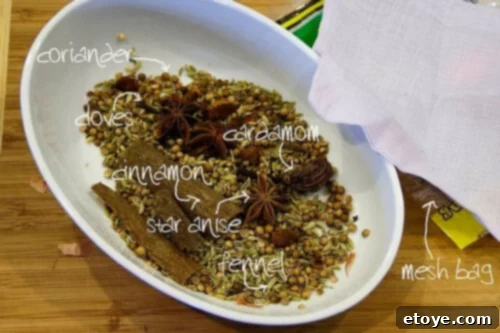
Selecting the Best Beef Bones for Your Pho Broth
The foundation of an outstanding Pho broth lies in the choice of beef bones. For unparalleled richness, body, and flavor, knuckle bones are unequivocally the best. These knobby bones, roughly the size of your fist, are packed with gelatin. Gelatin, when extracted during slow simmering, provides that incredible mouthfeel and richness that elevates a good broth to a great one. Knuckle bones genuinely make the most significant difference in the quality of your finished broth.
You can often find knuckle bones at Asian markets, where they are typically sold specifically for Pho broth, sometimes already cut into convenient 3-inch sections and available in the freezer section if not fresh. If you’re shopping at a regular supermarket, don’t hesitate to ask your butcher for them; they might have them in the back or can order them for you.
Leg bones are also essential, particularly those containing marrow. While marrow adds desirable richness, it can also contribute significant fat. If you have a generous amount of marrow bones, consider scooping out some of the marrow after the parboiling step (explained below), while the bones are still hot. Too much marrow can result in a greasy film on your broth, though some is definitely beneficial for flavor. Aim for a balance.
Can’t Find Specific Beef Bones? No Problem!
Life happens, and sometimes the ideal bones aren’t available. But don’t let that deter you from making Pho! If you can’t source leg or knuckle bones, here’s an excellent combination that will still yield a rich, flavorful broth:
This combination ensures you get a good mix of bone, cartilage, and meat, providing a robust and delicious base for your Pho.
The Critical Step: You Must Parboil Bones First
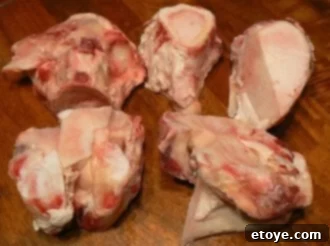
This initial parboiling step is non-negotiable for achieving a truly pure, clean, and crystal-clear Pho broth. Submerging the bones in rapidly boiling water for a short period effectively purges them of impurities like blood particles, small bone fragments, and undesirable extra fat. As the bones boil, you’ll observe a pinkish-gray foam rising to the surface – this is precisely what you want to eliminate.
Allow the water to come to a vigorous, hard boil, then continue boiling the bones for approximately 3 minutes. After this crucial time, carefully dump out all the water and the bones into a clean sink. Thoroughly rinse both the bones and your stockpot. Then, refill the pot with fresh, clean, cool water before proceeding with the main simmering process. While it’s an extra step, it is absolutely vital for a pure, clean-tasting broth that forms the perfect canvas for your spices and beef flavors. Skipping this step will result in a cloudy, potentially off-tasting broth, making all your hard work less impactful.
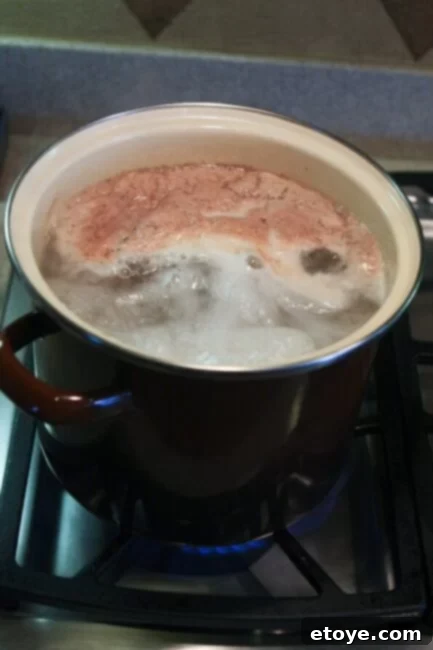
If you have marrow bones, and particularly if there’s a lot of marrow, it’s beneficial to scoop out some of it after parboiling. Do this while the bones are still hot, as the marrow is easiest to remove when warm. Use a small spoon or knife to extract and discard a portion of the marrow. This helps prevent an overly greasy broth. However, don’t remove all of it; some marrow contributes a wonderful richness that’s desirable in Pho.
Should your broth still appear too fatty after simmering, or if you chose not to remove marrow, there are effective ways to de-fat it:
The Art of Charring Onions and Ginger for Enhanced Flavor
Charring or roasting the onions and ginger is a cornerstone technique in traditional Pho preparation. This simple yet profound step transforms these humble aromatics, imparting a wonderfully mellow, naturally sweet, and slightly smoky flavor to your broth that cannot be achieved by simply boiling them. The high heat caramelizes their natural sugars and gently chars the outer layers, releasing deeper, more complex notes that become integral to the Pho’s signature taste.
While traditionally done over an open flame with tongs (which can be tiring and hot!), a much easier and equally effective method is to use your oven broiler. Simply place the halved onions and ginger, cut-side up, on a baking sheet. A light brush of oil can aid in charring. Position the baking rack about 8 inches below the broiler and cook for approximately 10 minutes, flipping halfway, until they are beautifully golden-brown with slightly blackened edges. The difference in color, as seen in the ginger below, indicates the depth of flavor you’re building. This technique ensures consistency and ease, allowing you to achieve that essential aromatic foundation without the fuss.


Achieving a Crystal-Clear Broth: Skimming Foam and Grease
One of the hallmarks of an expertly prepared Pho is its sparkling, clear broth. As your beef bones, aromatics, and spices gently simmer, you’ll inevitably notice foam (scum) and bits of fat rising to the surface. While some fat and marrow contribute to the broth’s richness and flavor, the greyish foam consists of impurities from the bones and meat. Removing this scum is paramount for a clean-tasting and visually appealing broth.
Regularly skimming the broth throughout the simmering process is crucial. A very fine-mesh strainer, often referred to as a “scum strainer,” is an invaluable tool for this task, effectively capturing foam and small impurities while allowing the beneficial fats to remain. By diligently removing the scum, you prevent it from breaking down and clouding your precious broth. Remember, the lower and gentler the simmer, the less foam will form, making the skimming process even easier.
Regarding simmering time, renowned Vietnamese cuisine experts like Andrea Nguyen and Corinne Trang (author of “Authentic Vietnamese Cooking”) advocate for a simmering period of approximately 3 hours. They assert that by this point, all the essential flavors and nutrients from the bones have been fully extracted, yielding a perfectly balanced and deeply flavored broth.
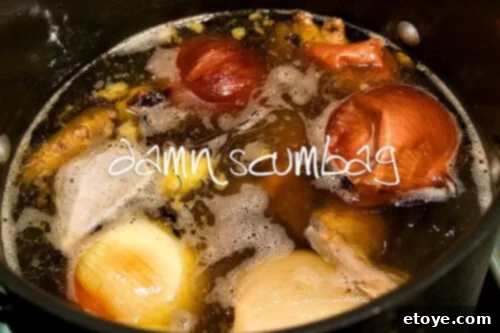
Perfectly Sliced Meats for the Ultimate Pho Experience
The beef in Pho is a key component, and its preparation significantly impacts the overall enjoyment of the dish. For the raw beef added to the bowl, you want cuts that are tender and cook quickly in the hot broth. Excellent choices include thinly sliced flank steak, London broil, sirloin, eye of round, or tri-tip steak. Some prefer to use pre-made beef balls (Bo Vien), which can be found in the refrigerated or freezer sections of Asian markets, adding a different texture to the soup.
The ultimate secret to slicing meat for Pho is to cut it as thinly as humanly possible and always *across the grain*. Cutting against the grain shortens the muscle fibers, resulting in incredibly tender meat that’s easy to chew. To achieve those paper-thin slices, a simple trick is to place the entire chunk of raw beef in the freezer for about 15 minutes before slicing. This firms up the meat, making it much easier to achieve uniform, delicate slices that will cook perfectly in the hot Pho broth.

Choosing Your Pho Noodles: Fresh vs. Dried Rice Noodles
Vietnamese Beef Noodle Soup, or Pho, is incomplete without its characteristic rice noodles. These soft, slippery strands are integral to the dish’s texture and overall appeal. You generally have two main options: dried or fresh rice noodles.
Many traditional restaurants, and home cooks, often use dried, flat rice noodles due to their accessibility and ease of storage. When selecting dried noodles, look for medium-thickness, flat varieties. Preparing them usually involves soaking them in hot water until they become pliable and opaque, then a quick blanch in boiling water before serving.
For an elevated experience, many connoisseurs prefer fresh rice noodles. These offer a distinctively soft, almost silken texture that is truly delightful. You can often find fresh rice noodles in the refrigerated or freezer sections of Asian markets. They typically require less preparation—just a quick rinse and untangling before a brief dip in boiling water. Whichever you choose, ensure they are cooked just right—al dente—to prevent them from becoming mushy in the hot broth.

Exploring Low-Carb Pho Alternatives
For those following a low-carb diet or looking for gluten-free options, enjoying the rich flavors of Vietnamese Pho is still entirely possible with a simple noodle substitution. Instead of traditional rice noodles, consider incorporating Shirataki noodles. Made from konjac yam, Shirataki noodles are incredibly low in carbohydrates and calories, offering a similar slippery texture without the carb count.
Another fantastic low-carb alternative comes from Korean cuisine: sweet potato noodles, often used in dishes like Japchae. These translucent, chewy noodles provide a satisfying mouthfeel and are a great option for those seeking an alternative to rice-based noodles. There are numerous recipes available that adapt Pho to be paleo-friendly and low-carb, ensuring that everyone can savor the deliciousness of this Vietnamese classic.
Traditional Pho Condiments and How to Enjoy Them
A visit to any Pho restaurant in Vietnam or abroad will invariably reveal a selection of condiments gracing every table, inviting diners to customize their soup to perfection. The two most common and beloved condiments for Pho are Sriracha hot chili sauce and Hoisin sauce. Sriracha offers a fiery kick, adding a vibrant heat to the broth, while Hoisin sauce provides a rich, sweet, and tangy counterpoint, often described as a Chinese BBQ sauce.
While many enthusiastically squirt generous amounts of both directly into their bowls, there’s a purist approach to consider. If you’ve invested hours in crafting a complex, flavor-packed, and crystal-clear broth, you might prefer to savor its unadulterated taste first. A common compromise is to dispense a small amount of each sauce into a separate dish and dip your sliced meats into them before taking a bite, allowing you to enjoy the condiments without altering the integrity of the broth itself. Experiment to find your preferred balance and enjoy the interactive aspect of customizing your Pho.
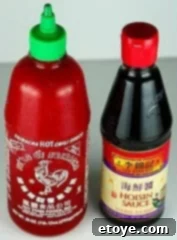
The Vibrant World of Pho Herbs and Vegetables
The finishing touch to any great Pho is an abundance of fresh herbs and vegetables, known as garnishes. These vibrant additions are not just for aesthetics; they are crucial for providing contrasting textures, bright flavors, and aromatic depth that complement the rich broth. Offering a communal plate of garnishes allows each diner to personalize their bowl, creating a truly interactive and delightful meal.
Among the most beloved accompaniments are fresh mint, offering a cooling, refreshing burst; cilantro, with its bright, herbaceous notes; and Thai basil, distinguished by its unique anise-like fragrance that perfectly harmonizes with the Pho spices. Crisp bean sprouts add a satisfying crunch and a subtle earthiness. For those who crave heat, thinly sliced chiles (like Thai or serrano peppers) provide a customizable kick. Finally, lime wedges are essential for squeezing fresh juice into the broth, which adds a crucial tangy acidity that brightens the entire soup and cuts through its richness. This diverse array of fresh elements transforms each bowl into a dynamic and flavorful experience.
Top Tips for an Unforgettable Homemade Pho

More Pho Recipes to Explore
Once you’ve mastered this traditional beef Pho, you might be eager to explore other delightful variations of this classic Vietnamese noodle soup:
Vietnamese Pho Recipe (Beef Pho)
Recipe adapted with permission from Into the Vietnamese Kitchen Cookbook by Andrea Nguyen.
Note: You can find “Pho Spice Pack” that includes all the spices at Asian markets. In Andrea’s cookbook, she uses star anise, cloves and cinnamon stick. Some prefer the addition of fennel, coriander and cardamom, and I’ve noted those ingredients as “optional” in the recipe.
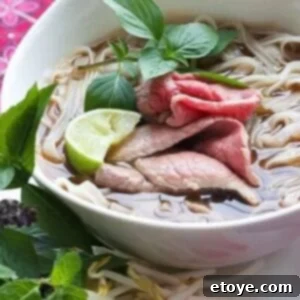
Recipe Details
Nutrition (per serving)
Ingredients
For the Pho broth
For the Pho Bowls
Garnish for Pho Recipe
Instructions
Make the Pho Broth
Assemble the bowls
What the Pho?! Deep Dive into Vietnamese Culinary Wisdom
For those passionate about mastering Vietnamese cuisine, the quest for the perfect Pho recipe can be a long and delicious journey of kitchen experiments, restaurant visits, and recipe scouring. Fortunately, an authoritative guide exists, and the best recipe I’ve found for Pho comes from Andrea Nguyen’s exceptional cookbook, “Into the Vietnamese Kitchen.”
This book stands as one of the most comprehensive and respected resources on the cuisine of Vietnam. Andrea Nguyen, an award-winning author and foremost expert, provides not just recipes but also a deep understanding of techniques, ingredients, and the cultural context of Vietnamese cooking. Her dedication to authenticity and clarity has earned “Into the Vietnamese Kitchen” prestigious nominations, including a James Beard Foundation award and two International Association of Culinary Professionals (IACP) awards. It is, without a doubt, a must-have book for any serious lover of Asian food and a true testament to the richness and diversity of Vietnamese culinary traditions. Delving into its pages is like having a master chef guide you through every step of this intricate yet rewarding cuisine.
Have you tried this authentic Vietnamese Pho recipe? We’d love to hear about your experience! Feel free to leave a star rating and share your thoughts and tips in the comments below. Your feedback helps our community of food lovers grow and discover new culinary delights!
